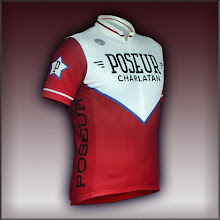With Mr. Issakove's permission I am reprinting his thoughts:
I think that it might be effective to further our cause by presenting the safety advice given to motorcyclists with respect to lane positioning, and then to ask the question; "If this is good advice for motorcyclists, why is it not good advice that bicyclists should follow?"
The only plausible and reasonable response is "Because then they are going to get run over from behind, because they are so slow". Once they have articulated this, then they are more likely to seriously consider the evidence against that position.
After that, all that they have left is, "I don't care if it makes cyclists less safe, they need to stay out of the way." Perhaps I'm naive, but I believe most people don't realize that this is, in the end, their position. If they can be made to see that they are holding to such a callus position, we will have an opportunity to change it.
Most people seem to honestly believe that the reason they are justified in believing that bicyclists should be out of the way is because bicyclists are unnecessarily endangering themselves. So, one way or the other, we need to convey that bicycling "out of the way" is often more dangerous than being "in the way".
That's why I think it's important to emphasize the dangers of riding "out of the way". Presenting the safety advice given to motorcyclists, and then asking your audience to consider the reasoning behind that advice. Why shouldn't these principals also apply to bicyclists? They do apply to operating a bicycle, and ought to be applied to our craft.
Serge
RANTWICK LOVES the USA
8 months ago



Rantwick says there is a problem posting comments. I hope not! Nonetheless he wished to say this:
ReplyDeleteI was going to give a big thumbs up on your "Guest Blog"... I think it goes straight to the heart of the matter, in ways people just might understand, if not appreciate.
Hey, comments are working for me now... did you change anything? Thanks for passing on my note.
ReplyDeleteYour welcome, Rantwick! For me, it's not all that hard to understand how computers and the internet work- It's all magic! So when stuff doesn't work, I can't fix it and I have to turn to wizards and witches to do that.
ReplyDeleteWhatever the problem was, it is gone now. Aren't you kind of amazed all this stuff works as well as it does anyway?
I agree completely with teaching motorcycling visibility techniques to bicyclists. High-speed cyclists, especially, need to understand sight line visibility. And any time hills are involved, even the pokiest of us can become high-speed bicyclists.
ReplyDeleteIn the interest of intellectual honesty, we must recognize that motorcycling produces about 16X the casualties per million hours as bicycling, and about 8X that of car driving. When you consider what a large percentage of bicyclists operate on the margins and in the ways most likely to expose them to risk, the statistics really prove how safe bicycling is. Most people can get away with extremely high-risk behavior, like riding next to parked cars, riding against traffic and passing large vehicles on the right, for years without getting killed.
What I've observed is that while people get away without injury, they experience frequent frustration, conflict, harassment (because they're unpredictable) and near-misses.
I've watched utterly incompetent, high-risk behavior daily for 6 years in the bike lane outside my office. I personally experienced numerous conflicts and near misses on that road before I understood how to outsmart the bike lane, and I was hit once. Even since, I've had doors thrown open (as I was passing at a safe distance). That no one has been killed on that road yet, is a total mystery. It will happen some day. That is inevitable.
What is significant about this, is that people don't put 2+2 together and recognize why their cycling experience is a constant struggle. They don't get the mechanics of it. That, coupled with enculturation into submissive inferiority, causes the cry for bike lanes... more bike lanes... solutions to the problems with those bike lanes... barrier separated bike lanes...
It's a spiral of dependency, special-interest whining and us-v-them bickering that follows a culture built on bike lanes.
When the public policy choice is to coddle and capitulate rather than empower and educate, we will all pay endlessly in a spiral of unintended consequences.
It's easy for the koolaid-drinkers to claim coddling is the only way to increase mode share. But, to my knowledge, no city in America has ever REALLY tried empowerment, education and access-oriented infrastructure.